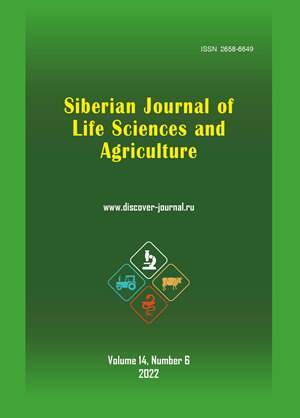ОЦЕНКА ГЕРОПРОТЕКТОРНОГО ПОТЕНЦИАЛА СКВАЛЕНА НА МОДЕЛИ CAENORHABDITIS ELEGANS
Аннотация
Обоснование. Увеличение здоровой продолжительности жизни является приоритетным направлением в современном здравоохранении. Сквален – тритерпен, проявляющий антиоксидантные, противовоспалительные и прочие свойства, является перспективным кандидатом в геропротекторы.
Цель. Оценить активность сквалена, то есть возможность его дальнейшего использования в качестве геропротектора.
Материалы и методы. Сквален приобретен в Sigma-Aldrich (США). Для исследования готовили растворы сквалена концентрацией 10, 50, 100, 200, 400, 800, 1600 мкмоль/л (растворитель диметилсульфоксид – ДМСО). Работа реализовывалась на базе Лаборатории биотестирования природных нутрицевтиков (ФГБОУ ВО «КемГУ», Россия). Антиоксидантную активность оценивали по улавливанию ABTS катион-радикалов в сравнении с активностью аскорбиновый кислоты. Модельный организм Caenorhabditis elegans N2 Bristol приобретен в Лаборатории разработки инновационных лекарственных средств и агробиотехнологий ФГАОУ ВО «МФТИ». Для оценки стрессоустойчивости нематод при культивировании создавали условия теплового (33°С) и окислительного (добавление 15 мкл 1 М параквата, 20°С) стресса в течение 24 и 48 ч. Для оценки продолжительности жизни культивирование осуществляли (при добавлении растворов сквалена) в нормальных условиях (20°С) в течение 61 дня. Статистическая значимость результатов оценивалась с помощью t-критерии Стьюдента (в программе Microsoft Office Excel 2007). Данные по продолжительности жизни оценивались с помощью графика выживания Каплана-Мейера в сочетании с критерием логарифмического ранга (Мантела-Кокса). Обработку данных осуществляли с помощью онлайн-приложения OASIS (https://sbi.postech.ac.kr/oasis/).
Результаты. Результаты показали, что растворы сквалена не проявляли антиоксидантные свойства, т.е. не улавливали ABTS катион-радикалы. Раствор сквалена концентрацией 10 мкМ способствовал увеличению стрессоустойчивости нематод. В условиях окислительного стресса выживаемость нематод при культивировании в течении 24 ч на 3,1 % выше, чем в контроле. В условиях теплового стресса при культивировании в течение 48 ч выживаемость выше на 11,3 %. На продолжительность жизни нематод растворы сквалена влияние не оказывали.
Заключение. Предположительно антиоксидантная активность сквалена выражается не в улавливании свободных радикалов, а в способности воздействовать на биомолекулы, приводящие к окислительному стрессу. Раствор сквалена концентрацией (10 мкМ) способен уменьшить негативное воздействие одного из факторов возникновения преждевременного старения. Для того чтобы оценить возможность использования сквалена в качестве геропротектора, не опираясь на улавливание катион-радикалов, необходимы дальнейшие исследования, изучающие воздействие вещества на прочие мишени, механизмы действия, связанные с возникновением возраст-ассоциированных заболеваний. Например, анализ влияния растворов сквалена на экспрессию генов (daf-2, daf-16, age-1, hsf-1 и т.д.), на наличие противовоспалительных, нейродегенеративных и прочих свойств.
Скачивания
Литература
Список литературы / References
Решетников В., Спиридович Е., Фоменко Т., Носов А. Растительная биотехнология – способ рационального использования биосинтетического потенциала // Наука и инновации. 2014.№ 5(135). С. 21–25 (Reshetnikov V., Spiridovich E., Fomenko T., Nosov A. Rastitel’naja biotehnologija – sposob racional’nogo ispol’zovanija biosinteticheskogo potenciala [Plant biotechnology - a way of natural use of biosynthetic sides]. Nauka i innovacii [Science and innovation], 2014, no. 5(135), pp. 21–25).
Amrit F.R., Ratnappan R., Keith S.A. et al. The C. elegans lifespan assay toolkit. Methods (San Diego, Calif.), 2014, vol. 68(3), pp. 465–475. https://doi.org/10.1016/j.ymeth.2014.04.002
Campisi J., Kapahi P., Lithgow G. J. et al. From discoveries in ageing research to therapeutics for healthy ageing. Nature, 2019, vol. 571(7764), pp. 183–192. https://doi.org/10.1038/s41586-019-1365-2
Cordeiro L.M., Machado M.L., da Silva A. F. et al. Rutin protects Huntington’s dis-ease through the insulin/IGF1 (IIS) signaling pathway and autophagy activity: Study in Caenorhabditis elegans model. Food and chemical toxicology : an inter-national journal published for the British Industrial Biological Research Association, 2020, vol. 141, 111323. https://doi.org/10.1016/j.fct.2020.111323
Dyshlyuk L.S., Dmitrieva A.I., Drozdova M.Y. et al. Relevance of bioassay of biologically active substances (BAS) with geroprotective properties in the model of the nematode Caenorhabditis elegans in experiments in vivo. Current aging science, 2021, https://doi.org/10.2174/1874609814666211202144911
Feng S., Cheng H., Xu Z. et al. Panax notoginseng polysaccharide increases stress resistance and extends lifespan in Caenorhabditis elegans. Journal of Functional Foods, 2018, vol. 45, pp. 15–23. https://doi.org/10.1016/j.jff.2018.03.034
Gohil N., Bhattacharjee G., Khambhati K. et al. Corrigendum: Engineering Strategies in Microorganisms for the Enhanced Production of Squalene: Advances, Challenges and Opportunities. Frontiers in bioengineering and biotechnology, 2019, vol. 7, 114. https://doi.org/10.3389/fbioe.2019.00114
Ibrahim N., Mohamed I. N. Interdependence of Anti-Inflammatory and Antioxidant Properties of Squalene-Implication for Cardiovascular Health. Life (Basel, Switzerland), 2021, vol. 11(2), 103. https://doi.org/10.3390/life11020103
Jabeen A., Parween N., Sayrav K. et al. Date (Phoenix dactylifera) seed and syringic acid exhibits antioxidative effect and lifespan extend-ing properties in Caenorhabditis elegans. Arabian Journal of Chemistry, 2020, vol. 13(12), pp. 9058–9067. https://doi.org/10.1016/j.arabjc.2020.10.028
Le V., Dolganyuk V., Sukhikh A. et al. Phytochemical Analysis of Symphytum officinale Root Culture Extract. Applied Sciences, 2021, vol. 11(10), pp. 4478. https://doi.org/10.3390/app11104478
Leite N.R., Araújo L., da Rocha P.D.S. et al. Baru Pulp (Dipteryx alata Vogel): Fruit from the Brazilian Savanna Protects against Oxidative Stress and Increases the Life Expectancy of Caenorhabditis elegans via SOD-3 and DAF-16. Biomolecules, 2020, vol. 10(8), 1106. https://doi.org/10.3390/biom10081106
Luo Y, Wu Y, Brown M, et al. Caenorhabditis elegans Model for Initial Screening and Mechanistic Evaluation of Potential New Drugs for Aging and Alzheimer’s Disease. In: Buccafusco JJ, editor. Methods of Behavior Analysis in Neuroscience. 2nd edition. Boca Raton (FL): CRC Press/Taylor & Francis; 2009. Chapter 16. https://www.ncbi.nlm.nih.gov/books/NBK5226/
Mastralexi A., Tsimidou M.Z. On the Squalene Content of CV Chondrolia Chalkidikis and Chalkidiki (Greece) Virgin Olive Oil. Molecules (Basel, Switzerland), 2021, vol. 26(19), 6007. https://doi.org/10.3390/molecules26196007
Micera M., Botto A., Geddo F. et al. Squalene: More than a Step toward Sterols. Antioxidants (Basel, Switzerland), 2020, vol. 9(8), 688. https://doi.org/10.3390/antiox9080688
Myers A., Lithgow G.J. Drugs that target aging: how do we discover them?. Expert opinion on drug discovery, 2019, vol. 14(6), pp. 541–548. https://doi.org/10.1080/17460441.2019.1597049
Nigon V.M., Félix M.A. History of research on C. elegans and other free-living nematodes as model organisms. WormBook: the online review of C. elegans biology, 2017, 2017, pp. 1–84. https://doi.org/10.1895/wormbook.1.181.1
Pallauf K., Duckstein N., Rimbach G. A literature review of flavo-noids and lifespan in model organisms. The Proceedings of the Nutrition Society, 2017, vol. 76(2), 145–162. https://doi.org/10.1017/S0029665116000720
Pandey S., Tiwari S., Kumar A. et al. Antioxidant and anti-aging potential of Juniper berry (Juniperus communis L.) essential oil in Caenorhabditis elegans model system. Industrial Crops and Products, 2018, vol. 120, pp. 113–122. https://doi.org/10.1016/j.indcrop.2018.04.066
Park H.H., Jung Y., Lee S.V. Survival assays using Caenorhabditis elegans. Molecules and cells, 2017, vol. 40(2), pp. 90–99. https://doi.org/10.14348/molcells.2017.0017
Popa O., Băbeanu N.E., Popa I. et al. Methods for obtaining and determination of squalene from natural sources. BioMed research international, 2015, 2015, pp. 367202. https://doi.org/10.1155/2015/367202
Potijun S., Jaingam S., Sanevas N. et al. Green Microalgae Strain Improvement for the Production of Sterols and Squalene. Plants (Basel, Switzerland), 2021, vol. 10(8), 1673. https://doi.org/10.3390/plants10081673
Re R., Pellegrini N., Proteggente A. et al. Antioxidant activity applying an improved ABTS radical cation decolorization assay. Free Radic. Biol. Med., 1999, 26, pp.1231–1237.
Sakul A., Ozansoy M., Elibol B. et al. Squalene attenuates the oxidative stress and activates AKT/mTOR pathway against cisplatin-induced kidney damage in mice. Turkish Journal of Biology, 2019, vol. 43(3), pp. 179–188. https://doi.org/10.3906/biy-1902-77
Sheng Y.Y., Xiang J., Wang K.R. et al. Extraction of Squalene From Tea Leaves (Camellia sinensis) and Its Variations With Leaf Maturity and Tea Cultivar. Frontiers in nutrition., 2022, vol. 9, 755514. https://doi.org/10.3389/fnut.2022.755514
Song B., Zheng B., Li T. et al. Raspberry extract promoted longevity and stress tolerance via the insulin/IGF signaling pathway and DAF-16 in Caenorhabditis elegans. Food & function, 2020, vol. 11(4), pp. 3598–3609. https://doi.org/10.1039/c9fo02845e
Song Y., Guan Z., van Merkerk R. et al. Production of Squalene in Bacillus subtilis by Squalene Synthase Screening and Metabolic Engineering. Journal of agricultural and food chemistry, 2020, vol. 68(15), pp. 4447–4455. https://doi.org/10.1021/acs.jafc.0c00375
Sugawara T., Sakamoto K. Quercetin enhances motility in aged and heat-stressed Caenorhabditis elegans nematodes by modulating both HSF-1 ac-tivity, and insulin-like and p38-MAPK signalling. PloS one, 2020, vol. 15(9), e0238528. https://doi.org/10.1371/journal.pone.0238528
Trifan A., Opitz S.E.W., Josuran R. et al. Evelyn Wolfram. Is comfrey root more than toxic pyrrolizidine alkaloids? Salvianolic acids among antioxidant polyphenols in comfrey (Symphytum officinale L.) roots. Food and Chemical Toxicology, 2018, vol. 112, pp. 178–187. https://doi.org/10.1016/j.fct.2017.12.051
Valachovič M., Hapala I. Biosynthetic Approaches to Squalene Production: The Case of Yeast. Methods in molecular biology (Clifton, N.J.), 2017, 1494, pp. 95–106. https://doi.org/10.1007/978-1-4939-6445-1_7
Vesnina A.D., Dmitrieva A.I., Asyakina L.K. et al. Relevance of the use of plant extracts in the creation of functional products that have a geroprotective effect. International Journal of Pharmaceutical Research, 2020, vol. 12(3), pp. 1865–1879. https://doi.org/10.31838/ijpr/2020.12.03.261
Wang H., Liu J., Li, T. et al. Blueberry extract promotes longevity and stress tolerance via DAF-16 in Caenorhabditis elegans. Food & function, 2018, vol. 9(10), pp. 5273–5282. https://doi.org/10.1039/c8fo01680a
Warleta F., Campos M., Allouche Y. et al. Squalene protects against oxidative DNA damage in MCF10A human mammary epithelial cells but not in MCF7 and MDA-MB-231 human breast cancer cells. Food and Chemical Toxicology, 2010, vol. 48(4), pp. 1092–1100. https://doi.org/10.1016/j.fct.2010.01.031
Xie Y., Sen B., Wang G. Mining terpenoids production and biosynthetic pathway in thraustochytrids. Bioresource technology, 2017, vol. 244(2), pp. 1269–1280. https://doi.org/10.1016/j.biortech.2017.05.002
Yang J.S., Nam H.J., Seo M. et al. OASIS: Online Application for the Survival Analysis of Lifespan Assays Performed in Aging Research. Plos one, 2011, vol. 6(8), e23525. https://doi.org/10.1371/journal.pone.0023525
Zamberlan D.C., Amaral G.P., Arantes L.P. et al. Rosmarinus officinalis L. increases Caenorhabditis elegans stress resistance and longevity in a DAF-16, HSF-1 and SKN-1-dependent manner. Brazilian journal of medical and biological research = Revista brasileira de pesquisas medicas e biologicas, 2016, vol. 49(9), e5235. https://doi.org/10.1590/1414-431X20165235
Zhao J., Zhu A., Sun Y. et al. Beneficial effects of sappanone A on lifespan and thermotolerance in Caenorhabditis elegans. European journal of pharmacology, 2020, vol. 888, 173558. https://doi.org/10.1016/j.ejphar.2020.173558
Zheng S.Q., Huang X.B., Xing T.K. et al. Chlorogenic Acid Extends the Lifespan of Caenorhabditis elegans via In-sulin/IGF-1 Signaling Pathway. The journals of gerontology. Series A, Biological sciences and medical sciences, 2017, vol. 72(4), pp. 464–472. https://doi.org/10.1093/gerona/glw105
Просмотров аннотации: 302 Загрузок PDF: 280
Copyright (c) 2023 Anna D. Vesnina, Vyacheslav F. Dolganyuk, Anastasia I. Dmitrieva, Anna I. Loseva, Irina S. Milentyeva

Это произведение доступно по лицензии Creative Commons «Attribution-NonCommercial-NoDerivatives» («Атрибуция — Некоммерческое использование — Без производных произведений») 4.0 Всемирная.






















































